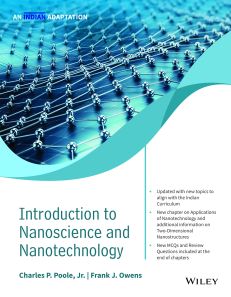Introduction to Nanoscience and Nanotechnology, An Indian Adaptation
ISBN: 9789354240201
508 pages
For more information write to us at: acadmktg@wiley.com

Description
This book is a comprehensive text and a ready reckoner on the theory and applications of nanotechnology. It provides an insight into the history of nanoscience and nanotechnology. It discusses in-depth the optical, mechanical, electrical, magnetic, and catalytic properties of materials at nanoscale. It is a comprehensive discourse on nanostructured ferromagnetism, optical and vibrational spectroscopy, quantum wells, self-assembly, and biological materials at nanoscale.
1 Introduction
1.1 History of Nanoscience and Nanotechnology
1.2 Definition and Classification of Nanomaterials
1.3 Present and Future Perspectives of Nanomaterials and Nanotechnology
2 Introduction to Solid State Physics
2.1 Structure
2.2 Energy Bands
2.3 Localized Particles
3 Methods of Measuring Properties
3.1 Introduction
3.2 Structure Analysis
3.3 Microscopic Techniques
3.4 Spectroscopic Techniques
4 Properties and Synthesis of Nanoparticles
4.1 Introduction
4.2 Metal Nanoclusters and Nanoparticles
4.3 Semiconducting Nanoparticles
4.4 Rare Gas and Molecular Clusters
4.5 Methods of Synthesis
4.6 Conclusion
5 Carbon-Based Nanostructures
5.1 Introduction
5.2 Carbon Molecules
5.3 Carbon Clusters
5.4 Carbon Nanotubes
5.5 Applications of Carbon Nanotubes
6 Nanostructured Materials
6.1 Solid Disordered Nanostructures
6.2 Nanostructured Crystals
7 Nanostructured Ferromagnetism
7.1 Basics of Ferromagnetism
7.2 Effect of Bulk Nanostructuring of Magnetic Properties
7.3 Dynamics of Nanomagnets
7.4 Nanopore Containment of Magnetic Particles
7.5 Nanocarbon Ferromagnets
7.6 Giant and Colossal Magnetoresistance
7.7 Ferrofluids
8 Optical and Vibrational Spectroscopy
8.1 Introduction
8.2 Infrared Frequency Range
8.3 Luminescence
9 Quantum Wells, Wires, and Dots
9.1 Introduction
9.2 Preparation of Quantum Nanostructures
9.3 Size and Dimensionality Effects
9.4 Excitons
9.5 Single-Electron Tunneling
9.6 Applications
9.7 Superconductivity
10 Self-Assembly and Catalysis
10.1 Self-Assembly
10.2 Catalysis
11 Organic Compounds and Polymers
11.1 Introduction
11.2 Forming and Characterizing Polymers
11.3 Nanocrystals
11.4 Polymers
11.5 Supramolecular Structures
12 Biological Materials
12.1 Introduction
12.2 Biological Building Blocks
12.3 Nucleic Acids
12.4 Biological Nanostructures
13 Nanomachines and Nanodevices
13.1 Microelectromechanical Systems (MEMS)
13.2 Nanoelectromechanical Systems (NEMS)
13.3 Molecular and Supramolecular Switches
14 Applications of Nanotechnology
14.1 Nanotechnology for Environmental Engineering
14.2 Nanotechnology for Textile Industry
14.3 Nanotechnology in Agriculture and Food
14.4 Nanotechnology Applications for Air and Soil
14.5 Nanotechnology in Industry, Defence, and Security
14.6 Water Demands for Nanotechnology
14.7 Therapeutics and Regenerative Medicine
14.8 Nanotechnology and the Energy Challenge
Summary
Keywords
Multiple-Choice Questions
Review Questions
Further Reading
Appendices
A Two-Dimensional Nanostructures
A.1 Introduction
A.2 Examples of 2D nanostructures
A.3 Synthesis of 2D Nanostructures
A.4 Applications of 2D Nanostructures
B Formulas for Dimensionality
B.1 Introduction
B.2 Delocalization
B.3 Partial Confinement
C Tabulations of Semiconducting Material Properties
D Answers to Multiple-Choice Questions
Index

